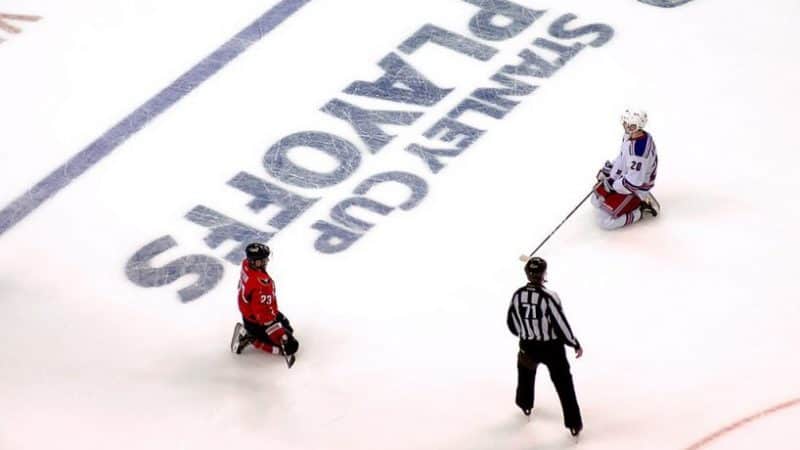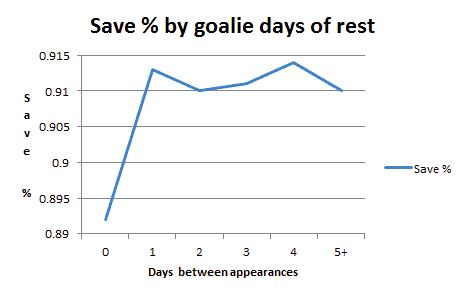
Having to play back to back games can be pretty tiring . (Photo credit: clydeorama via Foter.com / CC BY-NC)
Back-to-back games have become common on the National Hockey League schedule.
In 2016-17, the NHL forced the Buffalo Sabres and Columbus Blue Jackets to each play 19 sets of back-to-backs. Stretches of three games in four nights were also at an all-time high as the NHL had to cram an 82-game slate into a tighter window than usual, due to the World Cup of Hockey in September and the mandatory five-day “bye week” for players.
Had the NHL decided to participate in the 2018 Olympics (our fingers are still crossed, but the fact that the 2017-18 schedule has been released without an Olympic break is not a good sign), we might have seen even more back-to-backs for NHL teams.
Still, there will be a ton of times in 2017-18 when NHL squads have to lace up their skates on consecutive nights. Just ask the poor Ottawa Senators and Pittsburgh Penguins, who will both be asked to do that 19 times this upcoming season – meaning nearly half of their games (38 of 82) will either be the first or second leg of a back-to-back.
As NHL fans, it’s tough to complain about getting to see your team on TV two nights in a row.
But how can we capitalize as hockey bettors? Teams that are playing for the second straight night are at obvious disadvantages, especially when they’re playing an opponent that didn’t have to travel the previous day or that has had a few days off of practice and preparation.
Whether we are betting on Proline or with an online sportsbook, should we always be betting against teams that are playing the second game of a back-to-back?
Before we can answer that question, here are 3 things to consider.
1. Back-to-backs situations vary
Rested Oilers make meal of tired Ducks Leon Draisaitl scored two goals … https://t.co/F5wfp5dAHl #NBA #MLB #NHL pic.twitter.com/vNWhlopX0I
— GlobalSportsCentre (@GlobalSportsCtr) January 26, 2017
The most important thing to note when looking to bet against teams playing for the second straight night is that not all back-to-backs situations are created equal.
An obvious case of where a team playing the second game of a back-to-back won’t suffer as much is when their opponent is in the same predicament. Both sides will suffer from “tired legs”, especially in the third period when they’re playing their sixth period in a 24-hour span (this can make a strong Under bet, by the way.)
But here are a few other things that can increase/decrease the disadvantages of playing for the second straight night:
- How much travel was involved? One of the Maple Leafs’ back-to-back sets in 2017-18 involves a game in Chicago on Jan. 24, then a visit to Dallas the previous night. That’s a 2-hour flight, plus any delays getting to and from the airport. That’s a lot tougher than the back-to-back the Leafs will play March 14-15, when they are home to Dallas and then make the 1-hour drive to Buffalo.
- Did the team play overtime the previous night? Having to play 65 minutes (and maybe a shootout) instead of 60 is a bit more physical and mental wear and tear than simply playing a regulation time game.
- Did the team play an emotional game last night? If they’re coming off a big win against a hated rival, it could be hard to get psychologically “up” to play well again the next day.
- Is the team “used to” playing a tougher schedule? Teams in the western conference are used to a lot more travel than their eastern counterparts because their opponents are further apart. Teams in the northeast parts of the United States, meanwhile, play as many as 60 of their games within reasonable driving distance and could struggle a bit playing back-to-backs in California.
- How much depth does the team have? If a team is overly reliant on a particular defenceman or its top forward line, that could take a toll the following night. Either that star player is a lot more tired and not as effective, or he won’t see as much ice time and the role players will have a greater impact on the result.
2. How good is the starting goalie?
#Sens have back-to-back games coming up which means red-hot Andy will only start one #NHLhttps://t.co/DN5UxYKNrI pic.twitter.com/JaBYqW6Zx1
— Ottawa Sun (@ottawasuncom) December 29, 2015
Teams almost never use their top netminder in both games of back-to-backs.
A 2013 study by BroadStreetHockey.com showed that goalies playing for the second straight night had a much lower save percentage than they did when playing with 1 or more day of rest. Even goalies who hadn’t played a game in 5+ days had a save percentage of 0.910, compared to the 0.892 save percentage they posted when playing the second game of back to backs.

With goaltending such a critical factor in whether teams win or lose in today’s NHL, it only makes sense that the better the goaltending, the better a team’s record will be when playing the second game of back to backs.
If a team played its #1 guy last night, you should presume that their backup will be playing tonight (you can confirm this information at several different websites on the Internet, but sometimes the info isn’t out before you want to place your bet.)
In that case, look at the backup’s numbers to make sure this is a guy you want to bet on or against. Sometimes the betting line will be affected by the news that the backup is playing, creating some great value on his team if the backup is actually pretty good.
And if a team rested its starter in the first game of a back to back, you’re almost assured that he’ll be between the pipes for the second game (unless he’s injured or been playing horribly). That should make the team playing its second straight game a much stronger bet, especially if the odds on that team are discounted a bit because they’re playing on 0 days rest.
3. Are the odds right?
We mentioned the odds a little bit in our last point, but let’s expand on it a bit further here.
In a 2017 article, NHLTips.ca pointed out that over the past five years, teams have averaged 0.108 fewer points per game when playing the second game of back to backs than they have when playing with at least one day of rest. That may not sound like a lot, but earning 0.108 less of a possible 2 points represents a 5% drop in point production.
Generally speaking, the odds should reflect that disadvantage. In other words, a team that would normally be a +150 underdog when playing with rest should be closer to a +170 underdog if it’s playing on 0 days rest against a rested opponent.
If you think the odds do compensate for the fact that the team is playing on 0 days rest, it may be hard to find value in betting against that team. But if you think the odds haven’t been adjusted enough, you could have a great bet on your hands.
Of course, if the oddsmakers have adjusted the line a bit too much because of the fatigue disadvantage of playing back to backs, you’ll suddenly have value betting on the team that is playing for the second straight night.
Conclusion
The bottom line is that you shouldn’t just blindly bet against a team because it is playing the second game of back to backs.
Yes, they’re generally at a disadvantage, but there are lots of other factors to consider, such as the recent schedule of the team they’re playing, how much travel was involved (including time zone changes), possibility of emotional letdowns and the quality of goaltending.
Ultimately, it’s up to you to decide whether or not the oddsmakers’ adjustment to the betting line accurately represents the amount that a team is disadvantaged by playing for the second straight night.
Want better hockey odds? Check out the odds at offshore sportsbooks like Pinnacle or 5Dimes, where you only need to bet one game at a time instead of three games with Proline.

